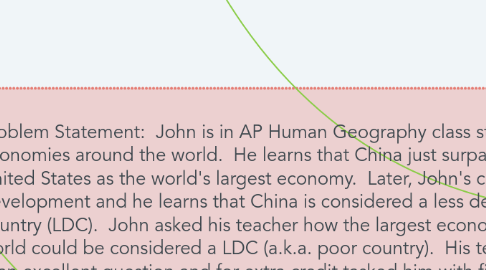CT Mind Map Exercise
by Rebecca Meek

1. Abstraction: John believes he can use those same indexes to show why other nations have or have not grown and developed in the last few decades. For his class he applies his algorithm to India to predict India's economic growth if they reduce their total fertility rate.
1.1. Rational: Yadav, Hong, and Stephenson (2016) suggest that abstraction is the ability to take the solution from one problem and apply it to another. When John takes his sequence of steps and applies them to India, he accomplishes abstraction. John's ability to use his steps as both a predictive and diagnosis tool proves relevant abstraction.
2. Algorithm: John formulates that he can use total population, birth rate, literacy rate and GNI per capita to measure the growth in development of a nations. From those measures he determines China 1st, decreased its fertility rate, allowing them to 2nd, decrease their dependency ratio, 3rd, increased their literacy rate, and 4th their educated population allowed for job growth within the large working population. These four steps allowed them to grow their economy into the largest in the world. While their population is still comparatively poor to counties like the United State, their per capita income is growing sharply and they have moved from extremely poor to a middle class economy.
2.1. Rational: After evaluating the different trends in data from China, John was able to create a sequence of steps that China went through to become the world's largest economy. According to Yadav, Hong, and Stephenson (2016) algorithm involves the use of sequence of steps to solve a problem. Google (n.d.) indicates that steps must apply to this and future problems. John's clearly defined steps gives a path to economic development for China and other developing nations.
3. Pattern Recognition: John learns from the United Nations (n.d.) development is measured with three elements, life expectancy, literacy rate, and Gross National Income (GNI) per capital. He learns from the World Factbook (n.d.) China ranks 1st in GNI but 105th in GNI per capita. John checks the World Bank (n.d.) rankings and learns in 1990, China's GNI per capita was $990, one of the lowest in the world. He checks the birth rate on the World Factbook (n.d) and discovers China has a birth rate of 12.1/1000 and ranks 161. Additionally, China has a total fertility rate of 1.6 ranking 181. Despite the low birth rate the World Factbook (n.d.) establishes China as the largest population with a low dependency ratio. Noticing this was one of the lowest rates in the world, John checks China's literacy rate. The Globalist (2014) website shows that China's literacy rate has grown from 78% in 1990 to 96% in 2016, one of the highest in the world. John starts to notice a pattern with increases in literacy rate and GNI per capita. He also notices a decline in birth rates that directly corresponds to those increases. Finally, he recognizes that China has the largest population in the world and largest economy in the world, making a correlation between workforce and size of the economy.
3.1. Rational: While looking at the different indexes, John observed certain trends between population growth, education, and economic growth. Google (n.d.) states that pattern recognition is observing patterns and trends in data.
4. Decomposition: John decides to learn more about China and break down the elements defining a nations's status economically and developmentally. By looking at the different indexes, John can look for indicators to suggest an answer. John goes to the CIA World Factbook, UN's Human Development Report, and the free web. John learns that each part of a country economy and demographics are measured.
4.1. Rational: In this scenario John needs to break down the elements that make up development and the economy to understand how they all work together. Google (n.d.) describes decomposition as breaking down the data or problem into smaller parts. By looking to the World Fact-book and UN's HDI, John can learn the relevant indexes that measure the economy and development.
5. Problem Statement: John is in AP Human Geography class studying economies around the world. He learns that China just surpassed the United States as the world's largest economy. Later, John's class is studying development and he learns that China is considered a less developed country (LDC). John asked his teacher how the largest economy in the world could be considered a LDC (a.k.a. poor country). His teacher says that is an excellent question and for extra credit tasked him with finding the answer and presenting it to the class.
6. References
6.1. 11 Facts: China's Improving Literacy Rate. (2014, December 10). Retrieved February 25, 2019, from https://www.theglobalist.com/11-facts-chinas-improving-literacy-rate/
6.2. Computational Thinking for Educators - - Unit 1 - Introducing Computational Thinking. (n.d.). Retrieved February 25, 2019, from https://computationalthinkingcourse.withgoogle.com/unit
6.3. GNI per capita, PPP (current international $). (n.d.). Retrieved February 25, 2019, from https://data.worldbank.org/indicator/NY.GNP.PCAP.PP.CD?locations=CN
6.4. Human Development Reports. (n.d.). Retrieved February 25, 2019, from http://hdr.undp.org/en/content/human-development-index-hdi
6.5. The World Factbook: China. (2018, February 01). Retrieved February 25, 2019, from https://www.cia.gov/library/publications/the-world-factbook/geos/ch.html
6.6. Yadav, A., Hong, H. & Stephenson, C. (2016). Computational thinking for all: Pedagogical approaches to embedding 21st century problem solving in K-12 classrooms. TechTrends, 60(6), 565-568.
7. Just a note, Mind Meister will not allow text within a bubble to be altered. Therefore, I could not italicize the titles and citations will have limited text changes.


